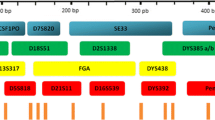Abstract
A multiplex PCR was designed for the loci D2S1338, D16S539, D18S51, TH01 and FGA using redesigned primers in order to reduce the lengths of the amplification products compared to the designs used in commercially available multiplex PCR kits, also including amelogenin. The new PCR primers were used to amplify highly degraded DNA from casework samples, which had shown no or only poor results for these loci in previous analyses with standard primer sets. The application of the new miniSTR-multiplex resulted in an increased overall typing success rate for degraded DNA samples. In a concordance study between the conventional and the newly designed primers, no genotype differences were revealed in 124 randomly selected individuals.



Similar content being viewed by others
References
Alvarez GA, Munoz I, Pestoni C, Lareu MV, Rodriguez-Calvo MS, Carracedo A (1996) Effect of environmental factors on PCR-DNA analysis from dental pulp. Int J Leg Med 109:125–129
Pfeiffer H, Huhne J, Seitz B, Brinkmann B (1999) Influence of soil storage and exposure period on DNA recovery from teeth. Int J Leg Med 112:142–144
Schneider PM, Bender K, Mayr WR et al (2004) STR analysis of artificially degraded DNA—results of a collaborative European exercise. Forensic Sci Int 139:123–134
Bender K, Farfan MJ, Schneider PM (2004) Preparation of degraded human DNA under controlled conditions. Forensic Sci Int 139:135–140
Butler JM, Shen Y, McCord BR (2003) The development of reduced size STR amplicons as tools for analysis of degraded DNA. J Forensic Sci 48:1054–1064
Grubwieser P, Mühlmann R, Parson W (2003) New sensitive amplification primers for the STR locus D2S1338 for degraded casework DNA. Int J Leg Med 117:185–188
Hellmann A, Rohleder U, Schmitter H, Wittig M (2001) STR typing of human telogen hairs—a new approach. Int J Leg Med 114:269–273
Ricci U, Klintschar M, Neuhuber F, Giovannucci Uzielli ML (1998) Study on the STR TPOX in an Italian and an Austrian population using two different primer pairs and three different electrophoretic methods. Int J Leg Med 111:212–214
Wiegand P, Kleiber M (2001) Less is more—length reduction of STR amplicons using redesigned primers. Int J Leg Med 114:285–287
Yoshida K, Sekiguchi K, Kasai K, Sato H, Seta S, Sensabaugh GF (1997) Evaluation of new primers for CSF1PO. Int J Leg Med 110:36–38
Oberacher H, Parson W, Mühlmann R, Huber CG (2001) Analysis of polymerase chain reaction products by on-line liquid chromatography–mass spectrometry for genotyping of polymorphic short tandem repeat loci. Anal Chem 73:5109–5115
Coble MD, Butler JM (2005) Characterization of new miniSTR loci to aid analysis of degraded DNA. J Forensic Sci 50:43–53
Schneider PM, Martin PD (2001) Criminal DNA databases: the European situation. Forensic Sci Int 119:232–238
Walsh PS, Metzger DA, Higuchi R (1991) Chelex 100 as a medium for simple extraction of DNA for PCR-based typing from forensic material. BioTechniques 10:506–513
Parson W, Parsons TJ, Scheithauer R, Holland MM (1998) Population data for 101 Austrian Caucasian mitochondrial DNA d-loop sequences: application of mtDNA sequence analysis to a forensic case. Int J Leg Med 111:124–132
Mannucci A, Sullivan KM, Ivanov PL, Gill P (1994) Forensic application of a rapid and quantitative DNA sex test by amplification of the X–Y homologous gene amelogenin. Int J Leg Med 106:190–193
Parson W, Steinlechner M (2001) Efficient DNA database laboratory strategy for high through-put STR typing of reference samples. Forensic Sci Int 122:1–6
Acknowledgements
We would like to thank Hermann Schmitter and Andreas Hellmann (Bundeskriminalamt Wiesbaden, Germany) for their helpful discussion and providing primer sequences for the locus FGA. This study was partially supported by a grant of the Österreichische Nationalbank, Jubiläumsfondprojekt Nr.: S97/4 (Austrian National Bank).
Author information
Authors and Affiliations
Corresponding author
Rights and permissions
About this article
Cite this article
Grubwieser, P., Mühlmann, R., Berger, B. et al. A new “miniSTR-multiplex” displaying reduced amplicon lengths for the analysis of degraded DNA. Int J Legal Med 120, 115–120 (2006). https://doi.org/10.1007/s00414-005-0013-6
Received:
Accepted:
Published:
Issue Date:
DOI: https://doi.org/10.1007/s00414-005-0013-6




